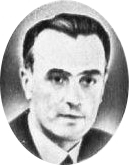Grigore Gafencu
| Grigore Gafencu | |
|---|---|
 |
|
| Minister of Foreign Affairs of Romania | |
|
In office February 1, 1939 – July 3, 1940 |
|
| Monarch | Carol II of Romania |
| Preceded by | Nicolae Petrescu-Comnen |
| Succeeded by | Mihail Manoilescu |
| Personal details | |
| Born |
January 30, 1892 Bucharest |
| Died | January 30, 1957 (aged 65) Paris |
Grigore Gafencu (Romanian pronunciation: [ɡriˈɡore ɡaˈfeŋku]; b. January 30, 1892, Bucharest - d. January 30, 1957, Paris) was a Romanian politician, diplomat and journalist.
Gafencu studied law and received his Ph.D. in law from the University of Bucharest. During World War I, he participated as a lieutenant and received the Mihai Viteazul Order for courage in battle. After the war, he became a journalist and founded the Timpul familiei newspaper, which was translated in French and distributed in many countries. At the age of 32, he became a National Peasants' Party deputy in the Romanian Chamber of Deputies (lower house of the Romanian Parliament) and was the assistant of the Minister of Foreign Affairs during the Iuliu Maniu government of 1928.
In 1938, he became a Minister of Foreign Affairs. For the next two years, he tried to assure the neutrality of Romania, which was caught up between Germany and the Soviet Union. Due to his efforts, he obtained guarantees from France and England, but those were not respected. After Northern Transylvania was annexed by Hungary as a result of the Second Vienna Award, and Bessarabia, Northern Bukovina and the Hertza region were annexed by the Soviet Union in 1940, he was sent as ambassador to Moscow, where he remained till the beginning of the war against the Soviet Union on 21 June 1941. During the war he settled in Geneva, Switzerland.
...
Wikipedia
